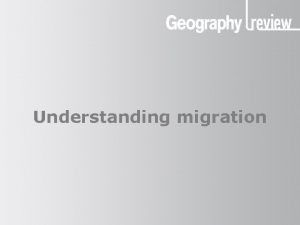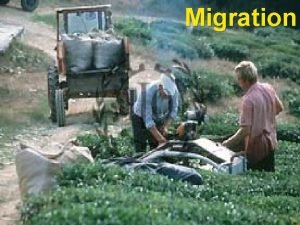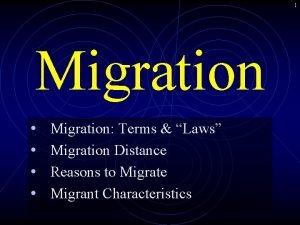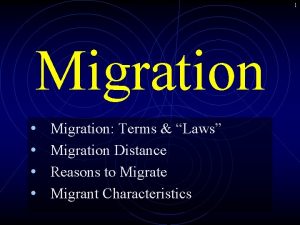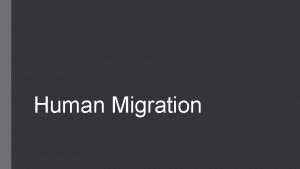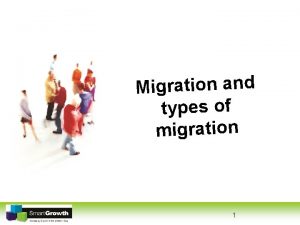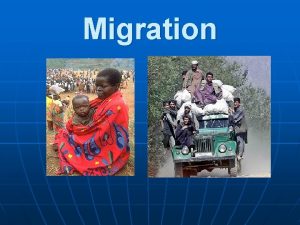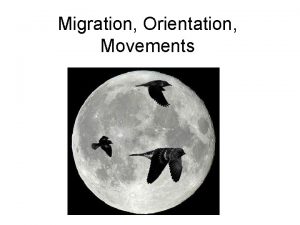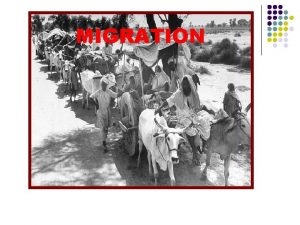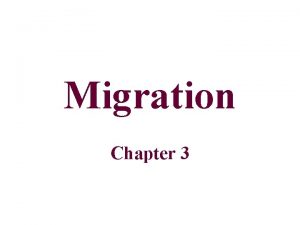Migration to the USA LOs understanding the migration






















- Slides: 22

Migration to the USA LO’s — understanding the migration process Describing the volume of migration to the USA SC — discussion, answering exam style questions

Complete the graph below using your information sheet

Years 1 st 2 nd 3 rd 4 th 1861 -70 Germany Ireland Britain Italy 1871 -80 Germany Britain Ireland Austria 1881 -90 Germany Ireland/ Britain Austria Italy 1891 -1900 Italy Austria Germany/ Russia Ireland 1901 -1910 Austria/ Italy Russia Poland Britain 1911 -1920 Italy/ Poland/ Russia Austria Britain Ireland/Germany

Task 2 Collect a map of Europe. a- shade in the countries which sent to most immigrants between 1851 and 1890. b- shade in the countries which sent the most countries between 1891 and 1920 Questions— Answer in sentences Where did most immigrants come from between 1851 -1890? Where did immigrants come from between 1890 and 1920? Between 1851 and 1920 where did most immigrants come from? Source C New York People, published in 1920 These new immigrants are different from people who came here twenty years ago. Then most of the immigrants spoke English or German. Now we have Italians and Poles and Russians. We never heard of them years ago. How fully does Source C describe the types of immigrants moving to the USA by 1920?

Migration Patterns of immigration Looks at the numbers of people moving from one place to another. If the number of people moving/ places where people move from stay the same — the pattern of migration stays the same. If the numbers of people moving or the places they move from changes then historians say the pattern of migration changed.

The population of the USA increased between 1870 and 1920. A likely reason for that change is because more people arrived in the USA between 1851 and 1920. The biggest change in the population took place between 1900 -1920. Between 1900 and 1920 the population of the USA increased by 30 million. Between 1851 and 1931 there was always at least 2 million people migrating to the USA every 10 years.

Compare Question Compare Sources A and B about the effects of immigration. Source A Andrew Chapman, New York policeman, 1920 The population of New York has grown so that it is 40 times bigger now than it was fifty years ago. The growth is caused entirely by immigration from abroad. . . The flood of people from Italy, Russia and Eastern Europe has led to overcrowding and bad housing conditions in some areas of the city but the new arrivals provided willing hands to build the railways, dig the subways and build the bridges. Source B It was the unskilled labour provided by the new immigrants which made possible the very fast growth in American industry around the year 1900. Immigrants speeded up industrial growth. Without immigration the number of people available to work would have been much lower than it was with the result that America would not have been able to grow so quickly.

Compare Question Source C American culture? There ain’ t such a thing. American culture is a mix of every culture in the world. Soon we’ll all just be Americans. Yesterday I was asked, ‘What’s an American? ’ The only answer I could give was ‘Somebody who came from somewhere else’. Source E We all had our own areas of the city. We called our area Little Italy. We were safe there coz all us Italians lived there. Just round the block there was Little Poland Little Russia. We spoke and ate and sang and prayed just like we had back home and we were free to do that. America was the land of the free. On what points do sources C and E agree or disagree?

Problems for Migrants What problems face new immigrants when they arrive in the USA?

Immigrant tensions “Old Immigrants” – families who have lived in the USA for several generations Thought they were important because they had made money, and their ancestors arrived a long time ago They despised new immigrants who had only just arrived and were poor - Had mostly arrived from Northern Europe

“New Immigrants” – had only just arrived in the USA Came from Southern Europe Arrived with very little English, so stayed near friends from the ‘old country’ Seldom mixed with other groups and kept to themselves – to outsiders they seemed strange and ‘no American’ so tension between the old and new immigrants was the result of snobbery, racism, ignorance and prejudice

WASP’s thought that they were better than everyone else – the most successful people in America in the early 20 th century were usually WASPs White Anglo Saxon Protestant

1920’s America Mexicans– moved north to escape poverty and war in their own country. They suffered because they were Catholic, ‘new immigrants’ and had coloured skin Orientals – People from Asia moved to the USA to find jobs such as building the railways. By 1900 the railways had been built and there was a strong prejudice against the ‘yellow’ people.

Native Americans Native (Red) Indians – an ethnic minority, they had a different culture and ethnicity. They are now called Native Americans as they are the only people who are not descended from immigrants 19 th century – Natives were pushed off of their land on to reservations (land that the white government allowed them to live on)

Blacks Until the 19 th century ‘Blacks’ had been slaves 1860’s slavery stopped Largest racial minority with very few rights Many lived in poverty and saw opportunity in the north so began to migrate within the USA

How fully does source A describe the prejudice to new immigrants? (5) Source A is from a letter to the Boston News in 1910. We created this nation by our sweat and blood. We made this country a Protestant nation. We came from countries in Europe that shared an Anglo Saxon tradition of hard work. Now we must suffer the arrival of the dirty, unwashed crowds from lazier countries. People with brown skins and yellow skins arrive daily. Catholics and Jews spread their superstitious beliefs in this Protestant country. Power in America should be in the hands of the ‘WASP’ people who made it great.

Task Collect and complete the hand out “ Immigrants and Slum Housing” Complete questions 2 -6 in your jotter

Open Door Closes LO’s - Describe what is meant by an ‘open door policy’ Understand why America ‘closed’ its door Describe why America passed new laws to discriminate against specific minorities

Language Barrier Racial Tension Problems faced by new immigrants Religious Conflict Slums Poverty

Effect of 1921/24 Immigration Acts was discrimination against southern Europeans. 1882 Chinese Exclusion act - restricts immigration into the USA 1902 Chinese immigration made illegal 1907 Japanese government promised to stop emigration to the USA 1918 Open door policy was closing and US policy towards immigrants was becoming more racist 1921 The law said that only 3% of each nationality living in the USA in 1910 would be allowed to enter the USA. 1924 Total of 150, 000 immigrants for each year and the proportion from each country was decided on the sizes of the national groups in the USA by the 1890 census.

Dillingham Commission The commission thought that immigrants from places like A-H, Russia, Italy, Turkey, Lithuania, Rumania and Greece were inferior compared to the WASP- type immigrants who came over in the 1890’s. Recommends- literacy test 1918 - Great War ends, increasing number of immigrants from southern Europe Result — unemployment rises, strikes and letter-bomb campaigns against politicians Impact — Stopped immigration – increases racism

Fear of unemployment Believed immigrants were inferior Why were Americans against immigration in the 1920’s? Housing shortage Believed immigrants were criminals Fears of revolution
 Solid
Solid Hình ảnh bộ gõ cơ thể búng tay
Hình ảnh bộ gõ cơ thể búng tay Bổ thể
Bổ thể Tỉ lệ cơ thể trẻ em
Tỉ lệ cơ thể trẻ em Chó sói
Chó sói Chụp tư thế worms-breton
Chụp tư thế worms-breton Chúa yêu trần thế alleluia
Chúa yêu trần thế alleluia Các môn thể thao bắt đầu bằng tiếng bóng
Các môn thể thao bắt đầu bằng tiếng bóng Thế nào là hệ số cao nhất
Thế nào là hệ số cao nhất Các châu lục và đại dương trên thế giới
Các châu lục và đại dương trên thế giới Công thức tính thế năng
Công thức tính thế năng Trời xanh đây là của chúng ta thể thơ
Trời xanh đây là của chúng ta thể thơ Mật thư tọa độ 5x5
Mật thư tọa độ 5x5 101012 bằng
101012 bằng độ dài liên kết
độ dài liên kết Các châu lục và đại dương trên thế giới
Các châu lục và đại dương trên thế giới Thơ thất ngôn tứ tuyệt đường luật
Thơ thất ngôn tứ tuyệt đường luật Quá trình desamine hóa có thể tạo ra
Quá trình desamine hóa có thể tạo ra Một số thể thơ truyền thống
Một số thể thơ truyền thống Bàn tay mà dây bẩn
Bàn tay mà dây bẩn Vẽ hình chiếu vuông góc của vật thể sau
Vẽ hình chiếu vuông góc của vật thể sau Nguyên nhân của sự mỏi cơ sinh 8
Nguyên nhân của sự mỏi cơ sinh 8























